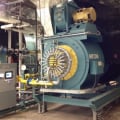Welcome! Here are the website rules, as well as some tips for using this forum.
Need to contact us? Visit https://heatinghelp.com/contact-us/.
Click here to Find a Contractor in your area.
If our community has helped you, please consider making a contribution to support this website. Thanks!
Feeder pump kills steam pressure...any solution?
Options
JUGHNE
Member Posts: 11,513
Have a pair of SIN8LNS Burnham 245,000 input boilers with the steam side piped together and the return side separated by feeder pump with electric solenoids on each boiler.
Whenever the feed pump adds water, the steam pressure that might have gotten to nearly 1 PSI is knocked down to zero and the gauge almost shows a bit of a vacuum.
The supply line to each boiler is throttled with a ball valve.
How much can you choke a 1/3HP 6 GPM feeder pump down before it suffers??
Whenever the feed pump adds water, the steam pressure that might have gotten to nearly 1 PSI is knocked down to zero and the gauge almost shows a bit of a vacuum.
The supply line to each boiler is throttled with a ball valve.
How much can you choke a 1/3HP 6 GPM feeder pump down before it suffers??
0
Comments
-
-
JUGHNE, I too use an amp meter when reducing flow on a condensate or boiler feed pump, as they all seem to be over sized. Second choice is to let me know the model number of the pump/receiver and I can send you a pump curve as well.
Sounds perhaps like a school in the north central part of the state.-1 -
Thanks to you both, Duh...that is really too simple.
I had my heating hat on and not the electrician hat.
Greg, not a school this time but a church.
The school has a 1,000,000 plus old CI. That one I tamed down with a 3/4" gas cock/plug valve. Just having it in line was enough to lengthen the run time.
These in the church are "new" from 2002 holding only 12 gallons of water each.0 -
In my experience, as the flow is reduced on a centrifugal pump, the amps go down. This is because the load is based on the volume the pump handles, not the pressure. Of course this does not apply if the boiler feed pumps are turbine or other positive displacement types.
To answer your specific question, so long as the boiler feed pump is a centrifugal type, you can pinch off the discharge to just short of no flow. The real problem here is internal heat buildup and possible damage to the mechanical seal.
I would think your problem is based on the feedwater temperature. Many boiler feed tanks will have an internal steam coil that will add heat to the feedwater before it enters the boiler
Hotter feedwater will have less effect on knocking down boiler steam.
Hope this is helpful.Dennis Pataki. Former Service Manager and Heating Pump Product Manager for Nash Engineering Company. Phone: 1-888 853 9963
Website: www.nashjenningspumps.com
The first step in solving any problem is TO IDENTIFY THE PROBLEM.1 -
Pumpguy, this is a Sterlco 4100 series 30 gal steel tank.
Pump has a small copper tube that goes back into the tank.
Is that meant to be cooling water...or a small bypass to insure a wet seal in case of dead head........ or to just prime?
The steel tank has no strainer on the inlet, the drain valve is plugged and I am sure there is a lot of crud in the bottom.
This entire system had every pipe 1" or smaller that was below the water line pretty well plugged up.
The pump will not start on occasion. The start cap is good.
Someone is monitoring the operation today as the LWCO systems for both boilers are questionable. Hope to change all that tomorrow.
Also the water inlet valve to the feeder tank plugged up twice as we were flushing boilers..........
"Everything was working fine until you starting cleaning things".0 -
The purpose of the 1/4" copper tube you refer to is to bleed off air that would be trapped in the pump's seal cavity, and insure that there is water in this cavity to cool and lubricate the mechanical shaft seal. When the pump is operating, the fluid flow through this tube is from the pump and back to the tank.
Pump starting issues could be due to worn or pitted centrifugal starting switch in the single phase motor, or similar problems with the level controls on the boiler.
I have yet to see a condensate pump receiver tank that has been in service for any reasonable period of time that doesn't have a layer of sediment in the bottom. Of course, some are worse than others.
I like to see a strainer on the inlet of these tanks. Wye strainers are okay, but I like basket strainers better. It goes without saying these strainers should be checked and cleaned from time to time. Unfortunately, too many never get checked.
Can't really comment on the crud build up. I would think it's related to the condensate and make up water's chemistry, but I will defer to others for comments on that subject.
Dennis Pataki. Former Service Manager and Heating Pump Product Manager for Nash Engineering Company. Phone: 1-888 853 9963
Website: www.nashjenningspumps.com
The first step in solving any problem is TO IDENTIFY THE PROBLEM.0 -
Seems like the feed water is too cold or is being fed faster than the boiler needs it.
If restricting the pump seems excessive (that's the way it is usually done) on the feed line to the boiler put a tee in and a return to the feed water tank. Put some sort of balancing valve on the return line and throttle it. This will let the pump pump. You can add feed water to the boiler slowly and keep the pump happy.
Are they adding to much cold feed water to the feed tank??0 -
Now that I think about it, this happens when I am there cleaning and flushing the boilers. So as I work on things and then refill and start up at the end of the day, I am using pretty cold water for feed purposes.
I need to have patience and observe when it is actually pumping hot/hotish condensate back from the system into the boiler.
But it is obvious that the fill time is very short.
I need to throttle that down but still get enough water back before the LWCO shut the burner down.
The bypass is a great idea, thanks.0 -
ahh, so thats what that little bleed line is on those feed tanks.
never stop learning............0 -
If I understand Pumpguy correctly then that tube would keep the pump wet and when it runs would pump some water back into the tank. A minimal bypass of water to prevent cavitation I assume.
We had an old firetruck with a 500 GPM pump that would easily reach 100PSI. I was dead heading the pump one time and noticed that the water coming out of the nozzle was hot! I eventually realized there was no bypass of any sorts. A 3/8" OD tubing going back into the tank cured that with no loss of performance. Our other pumpers with 750GPM have just that, a 3/8" tube from discharge back to inlet for that reason.
So if the feeder pump was throttled down with no amp overload danger but actual water flow was minimal then the water seal may not be in danger of overheating?0 -
> @JUGHNE said:
> Now that I think about it, this happens when I am there cleaning and flushing the boilers. So as I work on things and then refill and start up at the end of the day, I am using pretty cold water for feed purposes.
> I need to have patience and observe when it is actually pumping hot/hotish condensate back from the system into the boiler.
> But it is obvious that the fill time is very short.
> I need to throttle that down but still get enough water back before the LWCO shut the burner down.
>
> The bypass is a great idea, thanks.
Cold feedwater can do that for sure. I was working on two 700hp Cleaver Brooks steam boilers a few months ago that had this issue. And they hold a lot of water. They would reach 3-4 psi before calling for feedwater, and as soon as the feedwater pump came on the pressure would drop and the water level would instantly fall out of the gauge glass and trip the LWCOs. It turned out that there was a 2” condensate line that had broken in the system that was not returning to the tank. The tank was full of cold make-up water. To fix it temporarily I added a make-shift sparge tube to the tank and throttled the pumps down to fill the boiler more slowly. This got them by until they could repair the condensate line.
I’d be willing to bet your issue is from the colder feedwater after you put it back on-line.Never stop learning.-1 -
One of Dan's books has a great story in there about a pump exploding from deadheading, and a formula for figuring how fast this will happen if you deadhead the right kind of pump or the wrong kind as the case may be here LOL.
I think I'm right about that above comment. It may be that in that case both sides of the pump were isolated, and the pump was running and blew up as he left the room. Anyhow worth reading , really good story!0 -
-
It's the on/off action of the feed pump that's doing this. Modulating-feed control is much better, and preheating the feed water also helps.
Spirex/Sarco does a great job showing this in this video: https://www.youtube.com/watch?v=cI_DJ7v70M8
https://www.youtube.com/watch?v=cI_DJ7v70M8
The other videos in the series are just as good.Retired and loving it.1 -
For me, I believe after this is an a steady state of operation things will improve. We would have hot condensate returning, I will get the pumps to slow down the delivery rate. Even a bypass if needed.
Thanks again to Dan and Erin for this site, it is one of the most educational places to hang out on the internet.4 -
I believe you're right.
And thanks for the kind words!Retired and loving it.0 -
I was observing near "normal" operation today and the pump would run only from 6-10 seconds to satisfy the feeder control.
If I went with a by-pass, could it work if the bypass was connected to the pump discharge and back into a tee on the vent pipe? Single pump for 2 boilers with solenoid valve for each. Then adjust at bypass and also at each boiler.
I can see a dance coming up.0 -
Thank you!JUGHNE said:Thanks again to Dan and Erin for this site, it is one of the most educational places to hang out on the internet.
President
HeatingHelp.com0 -
I think that will work.Retired and loving it.0
Categories
- All Categories
- 87.3K THE MAIN WALL
- 3.2K A-C, Heat Pumps & Refrigeration
- 61 Biomass
- 429 Carbon Monoxide Awareness
- 120 Chimneys & Flues
- 2.1K Domestic Hot Water
- 5.8K Gas Heating
- 115 Geothermal
- 166 Indoor-Air Quality
- 3.7K Oil Heating
- 77 Pipe Deterioration
- 1K Plumbing
- 6.5K Radiant Heating
- 395 Solar
- 15.7K Strictly Steam
- 3.4K Thermostats and Controls
- 56 Water Quality
- 51 Industry Classes
- 50 Job Opportunities
- 18 Recall Announcements





